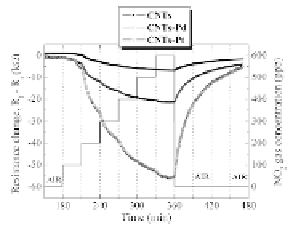Biomedical Engineering Reference
In-Depth Information
sputtering, provided higher sensitivity for significantly enhanced
gas detection of NO
, and CO up to a low limit of sub-ppm
level. The electrical resistance, at room temperature of unmodified
and Pt- and Pd-functionalized MWCNTs was measured as 32.5, 14.1,
and 13.4 k
, H
S, NH
2
2
3
, respectively. Thus, the metal modification of CNTs was
found to decrease electrical resistance of CNT-networked films.
The measured electrical conductance of the metal-functionalized
MWCNTs upon gas exposure was modulated by charge transfer
with
Ω
-type semiconducting characteristics. Pt- and Pd-clusters
functionalized MWCNT sensors exhibited better performance
compared to unmodified MWCNTs, making them promising
candidates for air pollutants' environmental monitoring. The
calculated limit of detection of the most performing Pt-modified CNT
sensor was as low as 3 ppb NO
p
, and 4 ppm
CO, working at 200°C. Figure 9.31 shows the scheme of fabricated
chemiresistor. Also, a simple electronic interface for chemiresistor
has been developed with a voltage output of sensor signal.
Figure 9.31 shows the detection at sub-ppm level ranging from 100
to 600 ppb NO
, 4 ppb H
S, 200 ppb NH
2
2
3
in the 30 min step-pulse format using the three
CNT sensors, at the operating temperature of 200°C. Both metal-
functionalized CNT sensors are higher sensitive than unmodified
CNT sensor due to the catalytic effect of the spill over with highest
2
Figure 9.31
(
) Schematic view of two-pole c hemiresitor based on
MWCNT-networked films functionalized with Pt- and Pd-
nanoclusters. (
Left
) Time response of three sensors based
on unmodified CNTs, 5 nm-loaded Pd- and Pt-modified CNTs,
exposed to various 30-minute pulses of NO
Right
gas ranging
from 100 to 600 ppb, at a sensor temperature of 200°C. This
figure is reprinted and adapted with permission from
Elsevier [247].
2




